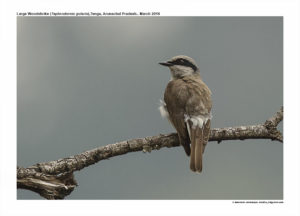Large Woodshrike

Large Woodshrike Tephrodornis virgatus
Etymology:
- Tephrodornis : Greek word tephrodes – like ashes, ash-coloured; ornis – bird
- Virgatus : Latin word for striped derived from virga –streak
Vernacular names: Hindi: Paharilatora,Mikir: Vohpigli, Lepcha: Ramnun-pho, Mal: Asurakkatan, Mar: MothaKokil-Khatik/ Rankhatik
Distribution inIndia:Resident of lower Himalayas, East, North East and South West of India
Description:Size of 22-23cm.It is a thickset bird with heavy bill, distinct nasal tufts. Male nominate race has white forehead, blue-black mask from lores around eye to ear-coverts; otherwise, blue-grey above, with white lower rump; primary coverts and remiges blackish, edged blue-grey, secondaries and tertials mostly blue-grey; upper tail-coverts and tail black; cheeks, neck side, throat and underparts white, slightly washed greyish-pink on breast; axillaries and underwing-coverts blue-grey; iris yellow-brown to yellow; bill black; legs grey-black. Female is duller than male, with paler upper wing-coverts, hardly any white on forehead, paler and browner mask, outer retrices edged and tipped white, eye sometimes pale blue, bill horn-brown.
Habitat:It is found in Broadleaf evergreen forest, mixed deciduous forest, forest edge, logged forest with some tall trees, secondary growth and woodland; sometimes overgrown teak plantations, wooded gardens and mangroves.
Food Habits:It is eats large insects, like Mantids, crickets, stick-insects,grasshoppers and locusts, beetles), dragonflies, large moths and caterpillars. It also eats some fruit like berries. Usually occurs in pairs; often associates with mixed-species foraging flocks of Minivets and Drongos
Breeding Habits:They breed in March-May. Nest a shallow saucer of interwoven fine grass stems, roots, twigs and tendrils, sometimes incorporating lichens, and bound with cobwebs, placed on horizontal tree branch above ground; constructed by both sexes. They Lay a clutch of 2–3 eggs .